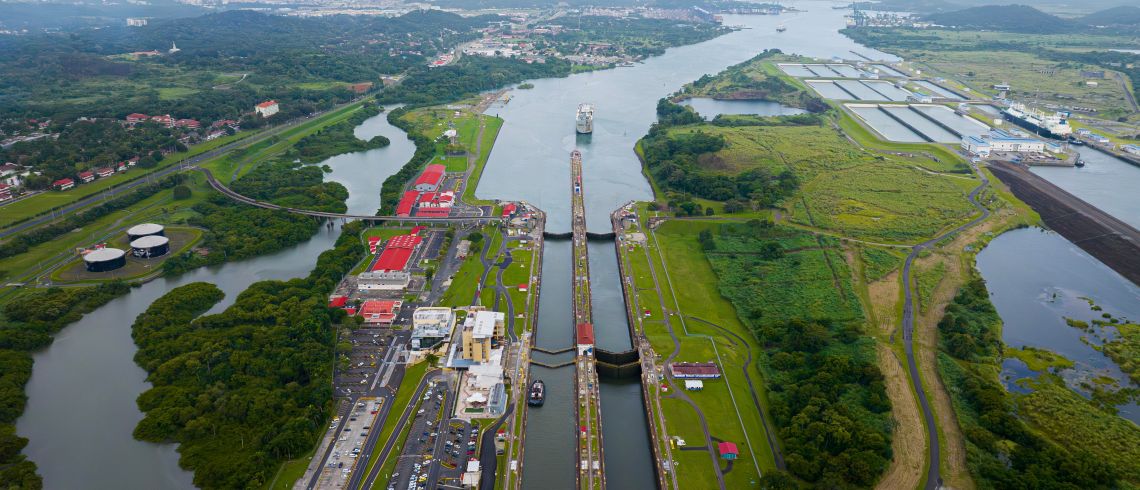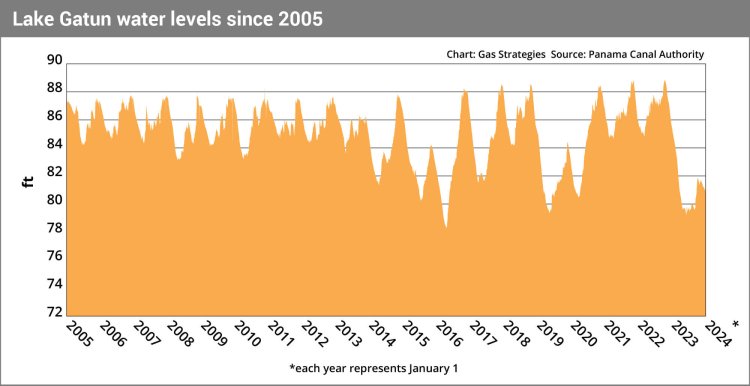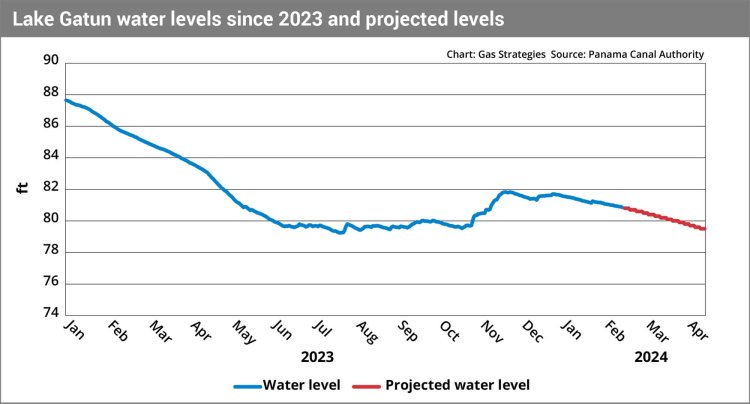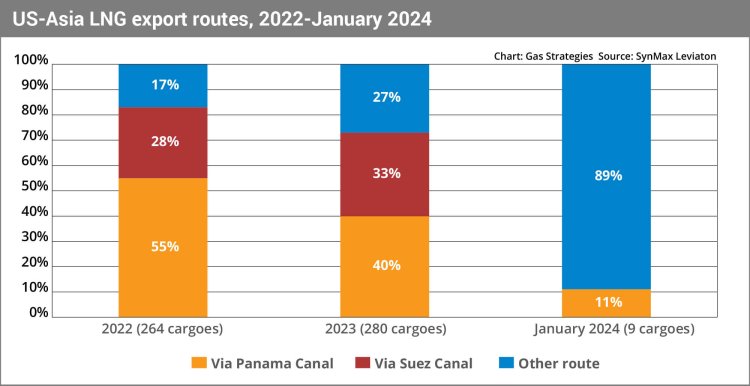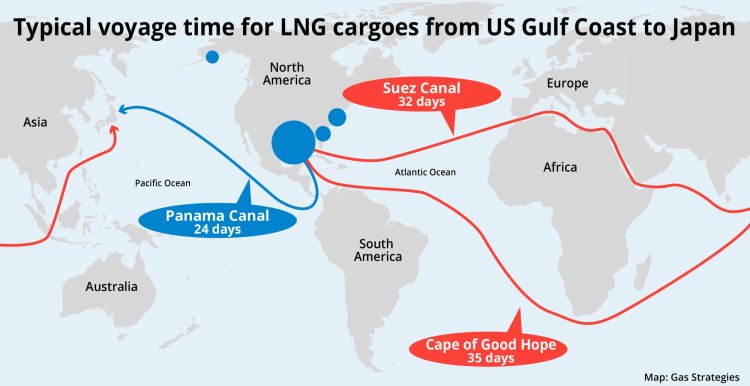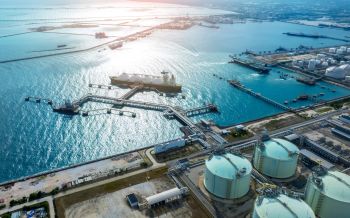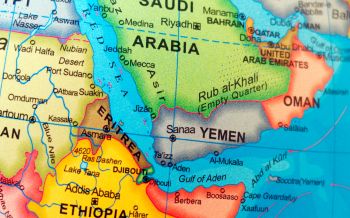- Panama Canal water levels hover around 80-ft mark since summer 2023, leading to first-ever cut in transit slots
- Container ships given priority under transit restrictions, leading LNG carriers to seek alternative, but longer, routes
- Under current system, slot availability for Asia-bound US LNG to be insufficient as Gulf of Mexico capacity grows
- Approval for new reservoir to boost water supply to canal rests in hands of Panama government and is no quick fix
Suppliers of LNG from the US Gulf Coast may have to get used to taking longer shipping routes to Asia that avoid the Panama Canal. Although the drought that has caused congestion at the canal in recent months is expected to ease later this year, a new reservoir to supply it with more water faces political hurdles and could take around five years to develop. In the meantime, the scale of the US liquefaction buildout will likely lead to more LNG cargoes lining up on their way to Asia than this key waterway can handle, industry sources tell LNG Business Review.
Extreme weather
Water levels at Lake Gatún, the artificial freshwater lake that forms part of the Panama Canal system and provides most of the water to operate its locks, have hovered around 80 ft for most of the past eight months. At this time of year, the water level should normally be 83-85 ft, says Erick Córdoba, the manager of the water division at the Panama Canal Authority (ACP), the autonomous Panamanian government agency that manages the waterway.
The water shortfall comes off the back of an extended dry season, exacerbated by the El Niño climate phenomenon, which can cause a rainfall deficit in the region. Córdoba’s team is trying to keep Lake Gatún’s water levels above 79 ft until the dry season ends in May.
As part of the efforts to manage the lack of water at the Panama Canal, the ACP last year successively trimmed the number of daily transit slots down from the standard level of 36. According to Córdoba, during previous droughts the ACP reduced the maximum draught for vessels but maintained the regular daily transit capacity. “This is the first time that we’ve had to cut slots,” he says. Due to the new restrictions, a logjam of over 200 vessels reportedly waited in August 2023 to transit at Panama.
By the end of October 2023, with the ACP warning that water levels at Lake Gatún were continuing “to decline to unprecedented levels for this time of year,” more cuts were announced. Daily transit capacity at the canal was gradually reduced to 22 by December 2023 and was set to fall to just 18 by February 2024, but following a period of rainfall, the number of daily slots has stayed at 24 since January.
“We are not expecting to decrease the number of transits per day,” Córdoba says. “Maybe in late May or mid-June, with the establishment of the wet season, we are going to be increasing the daily amount of vessel transits. The forecast is that we are going from El Niño to La Niña very quickly.”
According to Córdoba, the onset of La Niña is associated with more rainfall in Panama. “We expect by the end of this year we will have to deal with flood conditions,” he says. “I would say that the weather is becoming more extreme. Last year was the third El Niño in one decade.”
Impact on LNG shipping
A Panama Canal expert says LNG carriers “cannot ensure a booking slot because of the reduction in the number of transits” and as a result “are looking to alternatives.” Under the current transit restrictions, container ships are given priority over LNG carriers for booking slots to use the canal’s Neopanamax locks. Designed for vessels with larger dimensions than Panamaxes, which range between 50,000 dwt and 80,000 dwt, the Neopanamax locks were inaugurated in 2016 and are used by almost all LNG traffic.
With no guarantee that any booking slots will be available for LNG carriers, the only other option is to bid for a slot in the ACP’s auctions programme. An LPG tanker reportedly paid almost USD 4 million to secure a transit slot in an auction held in November last year.
Data from satellite analytics company SynMax shows that more LNG carriers are using alternatives to the Panama Canal, with provisional figures suggesting that only one of nine US LNG cargoes exported to Asia in January 2024 went through Panama. At the same time, LNG carriers have also avoided transits through the Suez Canal and Red Sea as a result of attacks on commercial shipping by Yemen’s Houthi militia. As a result, LNG shipping traffic has picked up via the Cape of Good Hope in South Africa.
“To go to Asia, historically there was not much utilisation of the Cape of Good Hope,” says Leslie Palti-Guzman, head of research and market intelligence at SynMax. “It really picks up [in 2023] as an alternative to the Panama Canal.” Shipping routes from the east coast of the US to Asia that bypass the Panama Canal add time to the rotation of a vessel, “so it ends up being more expensive,” she adds.
Palti-Guzman believes that the Panama Canal congestion strengthens the case for LNG export projects on the west coast of the Americas – for example in Canada and Mexico – that target the Asian market. “It makes sense for bypassing the [Panama Canal], but also in terms of shipping distance, it’s shorter to destination.”
LNG shippers would be willing to try their luck via the Red Sea if LNG prices were more attractive, believes Jason Feer, global head of business intelligence at energy and shipping consultancy Poten & Partners. “A modern, large newbuild LNG carrier will run you about USD 260 million to USD 270 million, so that’s just an awful lot of liability,” he explains. “There’s just no incentive … for US producers to try to push cargoes through the Mediterranean and Suez Canal. The prices for LNG just aren’t high enough.”
Palti-Guzman notes that the problems with shipping routes to Asia have made Europe a more attractive market for spot US LNG. “I think Europe is being prioritised by many of the traders,” she says. “Right now, with the difficulties of sending to Asia, either through the Panama Canal or via the Red Sea, it really emphasises the shorter routes to Europe because it makes economic sense, shipping sense.”
With QatarEnergy’s decision in January to halt LNG shipping via the Red Sea, Qatari LNG deliveries are also making longer journeys via the Cape on their way to Europe. Although spot LNG freight rates have been subdued by healthy gas storage levels in Europe and Asia, as well as the delivery of a record amount of new LNG carriers, the IEA warned in its Q1 ‘24 gas market report that the increase in time to deliver LNG cargoes could soon exert upward pressure on shipping costs.
The transit restrictions at the Panama Canal are not the only reason its LNG traffic has been reduced. Prior to the drought, the canal had lost a fair amount of its LNG business in the wake of Russia’s invasion of Ukraine, with price spreads encouraging more US LNG to be sent to Europe rather than Asia.
Between fiscal years 2021 and 2022, Panama Canal transits by LNG carriers fell 30% from 537 to 374, the ACP’s 2023 annual report shows, while in fiscal year 2023, transits by LNG carriers were down 12.8% year on year to 326.
READ Red Sea attacks: Crisis ‘non-issue’ for LNG so far but highlights chokepoint risks
“It‘s mostly just down to the fact that since around mid-2021 the arb has been for US LNG to go to Europe,” says Feer. “Since the outbreak of hostilities [in Ukraine], about two-thirds of US cargoes have gone to Europe and that compares with about 38% before,” he adds.
US LNG buildout
This trend is set to go the opposite direction in the next few years, putting pressure on the Panama Canal’s ability to handle a potential increase in transits, stresses Feer: “In our forecasts we have European LNG demand growing in 2024 and a bit in 2025 and then essentially flattening out.”
With the US accounting for nearly 40% of the 200 mtpa in new liquefaction capacity currently being built, “a lot of that [US] volume is going to have to find a home and that’s almost certainly going to be in Asia Pacific,” he observes. As a result, “there will be more demand for Panama Canal transits, but if you have one or two slots a day, that really may not be enough.”
The ACP allows up to two daily transit slots to be allocated to LNG carriers via its booking process, either for two northbound transits or one in each direction. From the perspective of US LNG exports, this has meant that under normal circumstances only one slot can be allocated each day to a laden carrier on a southbound transit to Asia.
“It gets worse if there’s a drought and capacity at the canal is constrained, but even if you can easily get a [LNG] ship a day through, that’s not going to cover most US exports to Asia,” says Feer. “It’s likely that a significant portion of US LNG is going to have to take the long way around no matter what.”
Reservoir plans
The Panama Canal has in recent years courted a bigger share of LNG shipments. According to the ACP, upon completion in 2016, the canal’s expansion project “opened the waterway to 90% of the global LNG fleet for the first time, offering significant time savings for LNG producers in the US and Latin America when exporting to the South America west coast and Asia.”
But the expansion of the Panama Canal strained water resources and stored up problems for the future. Its watershed basins supply water to around 2.5 million people, but during fiscal year 2023 the canal’s locks used an average of 91.45 cm of water per second, equivalent to two Olympic-size swimming pools approximately every minute.
READ Milestone year: LatAm and Caribbean await Mexico LNG exports while gas links shift
A source with knowledge of the canal says the expansion, approved by a referendum in 2006, did not follow the advice of engineers and consultants that pointed to the need for another reservoir. “The original programme determined that [the project] needed an additional source of water,” says the source.
In response to criticism from local social movements over the expansion, Panama’s legislature passed a law in June 2006 that reduced the amount of territory in the canal’s watershed under the ACP’s jurisdiction. The following month, Panama’s legislature passed another law that prohibited the construction of reservoirs for the expanded canal. Water sources such as the Indio River were moved outside of the ACP’s jurisdiction. Against this backdrop, a potential long-term solution to boosting water levels at the canal lies in the government’s hands rather than the ACP’s.
The ACP is calling on Panama’s government to modify the two laws passed in 2006 that block the authority from tapping additional water resources. A potential project would see a new reservoir built on the Indio River to increase the canal’s water supply, although no decision is likely to be taken by the government until after the country holds general elections on 5 May.
The ACP’s administrator, Ricaurte Vásquez Morales, said in an industry update late last year that his team was in talks with the government and would speak to a future administration about the Indio River project or any potential alternatives. “We have continuous conversations with the authorities in order to get it approved sometime in the next 12 months,” he said.
“We have several projects but Indio ranks in first place because it’s closer, it’s cheaper, it’s faster, it’s under the budget,” says Córdoba. However, the Rio Indio reservoir project would not be a quick fix. Córdoba believes five years would be a realistic timeline to complete the project. - EO
Subscription Benefits
Our three titles – LNG Business Review, Gas Matters and Gas Matters Today – tackle the biggest questions on global developments and major industry trends through a mixture of news, profiles and analysis.
LNG Business Review
LNG Business Review seeks to discover new truths about today’s LNG industry. It strives to widen market players’ scope of reference by actively engaging with events, offering new perspectives while challenging existing ones, and never shying away from being a platform for debate.
Gas Matters
Gas Matters digs deep into the stories of today, keeping the challenges of tomorrow in its sights. Weekly features and interviews, informed by unrivalled in-house expertise, offer a fresh perspective on events as well as thoughtful, intelligent analysis that dares to challenge the status quo.
Gas Matters Today
Gas Matters Today cuts through the bluster of online news and views to offer trustworthy, informed perspectives on major events shaping the gas and LNG industries. This daily news service provides unparalleled insight by drawing on the collective knowledge of in-house reporters, specialist contributors and extensive archive to go beyond the headlines, making it essential reading for gas industry professionals.

